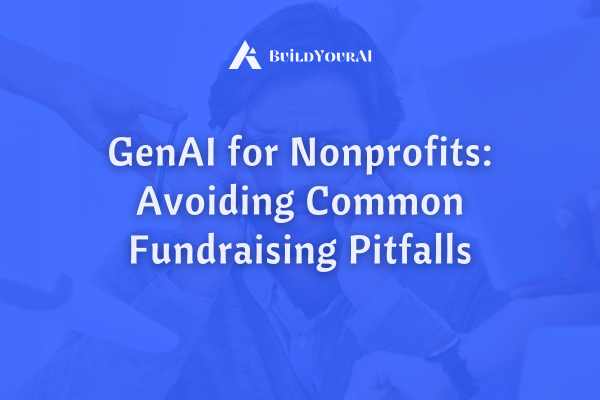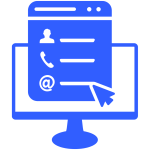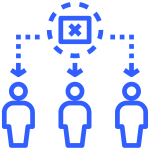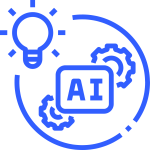
Blog
October 29, 2024 • 3 min read
Fundraising is a delicate balance of art and science. As an owner searching for fundraising ideas for nonprofit organizations, you must use data analytics with compelling storytelling. AI for non-profits has proved to be a timesaver in more ways than one. Nonprofits are increasingly exploring how GenAI can enhance their fundraising efforts, streamline processes, and improve efficiency. Yet, while AI can be a powerful tool for nonprofits, implementation isn’t always successful.
Here are six common mistakes you can avoid when learning how to implement AI for your nonprofit effectively.
Mistake #1: Vague Prompts with No Proper Context

One of the biggest mistakes when using GenAI is providing vague or incomplete prompts. Remember, chatting with GenAI isn’t the same as talking to a person. It doesn’t have context or personal knowledge and understanding. To get the best results, be as specific as possible.
For example:
Instead of saying, ” Write a fundraising letter,” try: “You are an expert fundraising copywriter. Write a persuasive fundraising letter for a local animal shelter, targeting donors aged 35-55. The letter should highlight the shelter’s mission, success stories, and the urgent need for funds.”
Define the target audience, what channel you are creating content for, and how you want the style and tone of voice to be. Giving the chatbot context will give you a more relevant response that resonates with your supporters.
Mistake #2: The Pitfall of Poor Data Quality

You need data for AI to work its magic. Just as a building needs a strong foundation, AI relies on accurate and up-to-date data to produce quality results. Inaccurate data can lead to misleading insights and ineffective campaigns.
If you insert outdated contact information, AI will not identify donors correctly, which can waste time and resources on ineffective outreach, potentially damaging donor relationships.
Best Practices for Data Management:
- Regular Audits: Conduct frequent checks of your donor database to identify and correct errors.
- Consistent Data Entry: Establish clear guidelines for data entry to ensure accuracy and consistency.
- Automated Data Cleaning: Utilize tools that can automatically clean and update your data, saving time and reducing errors.
Mistake #3: Frustrating Donation Forms

Donors expect a smooth and easy donation process. Clunky or overly complicated donation forms can deter potential contributors and reduce conversation rates.
Best Practices for Optimizing Conversion
- Use Industry-Specific Fundraising Platforms: When checking for fundraising ideas for nonprofit organizations, utilize platforms designed specifically for fundraising to streamline the donation process and customize your assets.
- Harness AI Insights: Use AI and machine learning to analyze user behavior and identify pain points in your donation forms. For example, if many donors abandon the form after a certain step, consider making that section simple or breaking it up into multiple pages.
- Mobile Optimization: Ensure your donation forms are fully responsive and optimized for mobile devices, as a significant portion of donations are made on smartphones and tablets.
- Diverse Payment Options: Offer a variety of payment methods to accommodate different preferences and make it easier for donors to contribute.
- Continuous Improvement: Regularly analyze your donation form performance and make data-driven improvements to increase conversions.
Mistake #4: Ignoring Required Homework

One of the most common fundraising mistakes nonprofits make during their charity campaign planning is approaching potential donors without adequate research. This can lead to awkward conversations, ineffective asks, and missed opportunities.
Best Practices for Approaching Donors
- Segment Your Donors: Understand your donors and then categorize your donors based on their giving capacity and interests.
- Tailor Your Approach: Craft personalized appeals that resonate with each donor segment of your charity campaign.
- Research Your Prospects: Learn about their background, interests, and giving history.
- Avoid Guesswork: Don’t make assumptions about a donor’s giving capacity. Research their financial information and giving history.
- Listen Carefully: Pay attention to clues and hints during conversations that can indicate their potential giving level.
- Be Prepared to Adjust: Be flexible and willing to adjust your ask based on the conversation and your research.
Mistake #5: Lack of a Clear Roadmap

One of the biggest mistakes nonprofits make with AI is not having a clear plan for their charity campaign. With countless AI tools available, it’s crucial to know exactly what you want to achieve.
Instead of vague goals like “improve fundraising with AI,” or “AI-based fundraising ideas for nonprofit organizations” set specific, measurable, achievable, relevant, and time-bound (SMART) objectives.
For example
“Increase donor retention by 15% over the next year by using AI to personalize reminder emails.” This goal provides a clear direction and measurable outcome.
By setting SMART goals, you can effectively guide your AI implementation and measure its success.
Mistake #6: Neglecting to Measure Results

Setting goals is important, but tracking your progress is equally crucial. Regularly review your AI tools’ performance to ensure they’re delivering positive results.
Best Results to Quantify the Impact:
- Measure Time and Cost Savings: Calculate how much time and money AI has saved your organization. For example, if AI can complete a task in 10 seconds that previously took 30 minutes, you’re freeing up valuable time for your team.
- Set Benchmarks: Establish baseline metrics to track improvement over time.
Key Performance Indicators:
- Time Saved: Measure the reduction in time spent on specific tasks.
- Cost Savings: Calculate the financial benefits of using AI.
Increased Efficiency: Assess how AI has improved overall efficiency and productivity. - Improved Outcomes: Evaluate the impact of AI on fundraising results, such as increased donations or donor engagement.
Mistake #7: Underestimating the Importance of Training

While generative AI is becoming more accessible, it’s crucial to remember that effective use requires proper training. Even the most advanced AI tools are only as good as the people who use them.
Best Results for Successful Adoption:
Comprehensive Training: Ensure all stakeholders receive thorough training on how to use the AI tool safely and effectively.
Continuous Learning: Encourage ongoing education to keep users informed about the latest AI advancements and best practices.
Feedback Loops: Gather feedback from users to identify areas for improvement and address any usability issues.
Conclusion:
There’s no quick fix for successful fundraising. While trends like charity challenges and crowdfunding can be helpful, they won’t solve all your problems. Reaching your fundraising goals takes hard work and a well-thought-out strategy.
Know how your mission can make an impact with the best fundraising ideas for nonprofit organizations with BuildYourAI your free – your very own AI assistant that optimizes every aspect of your fundraising campaigns. Also, our CollabAI platform comes equipped with five specialized fundraising assistants:
- Grant Writing Assistant – Craft compelling proposals
- Fundraising Task Manager – Stay organized and on track
- Fundraising Idea Generator – Get innovative campaign concepts
- Event Checklist Assistant – Execute flawless fundraising events
- Board Member Onboarding Guide – Prepare your team for success
Mistakes are part of the process. Learn from them and keep moving forward. With the right approach, minor setbacks won’t derail your fundraising efforts.
